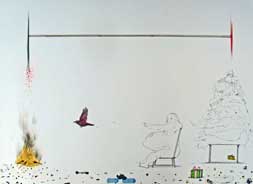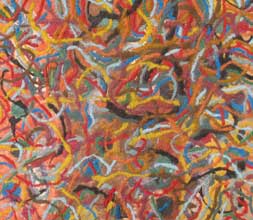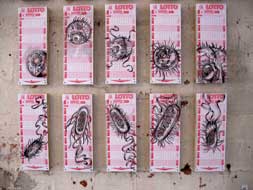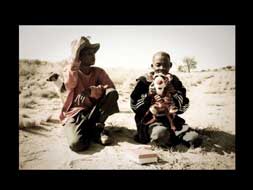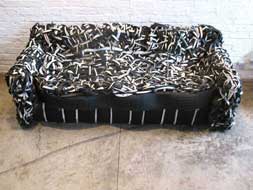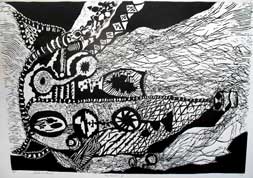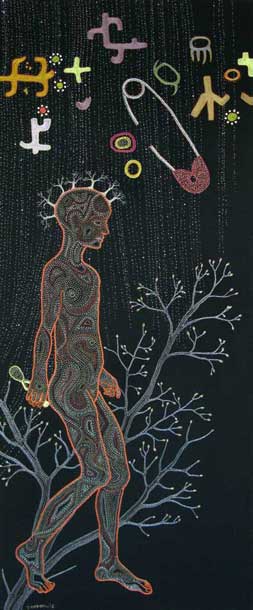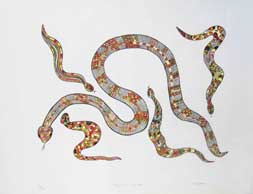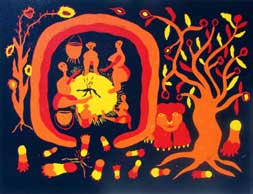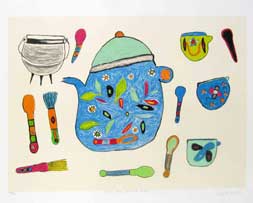Corner Fox / Main / Berea Streets
Google Map
Contact: mathroomcontact@gmail.com
Artists
Hunter-Gatherer Exhibition
- Virginia Ramovha
- Alice Edy
- Inkoom
Hunting and gathering is the epitome of our human nature, as it is linked to survival. What has transpired over the many thousands of years seems to be a warped evolution of the roots of creativity - the very thing that propelled the act of hunting and gathering.
- Phillipa Holden
- Bongani Khumalo
- Lehlohonolo Mkhasibe
- Tamar Mason
- Thamae Kaashe View 'Different Snakes' in Gallery
- Jan-John View 'Story Time' in Gallery
- Xaga View 'New Tea Set with Forks' in Gallery
Virginia Ramovha started her art career in earnest when she studied at the Funda Art School in Soweto, from 2006 to 2009. It was during this time that she developed a unique and abstract pictorial language, using coloured sand to portray images that hark on abstract expressionism, but also microbiology.
Her work is indicative of the ingenuity that South African artists have when it comes to using found materials - and the process of reinventing these materials. Sand has many connotations, especially that of the hourglass, and time. Ramovha's images somehow breathe life into a substance that is usually associated with desolation and inorganic matter.
View 'Spiritua' and 'Untitled' in Gallery
Title: "Progress" (Neuron / virus / bacteria / human/animal cells) Medium: Ink on Lottery Tickets
Odds of winning the National Lottery (South African) = 14 000 000:1 Odds of the sperm-cell (that would one day become you) reaching the egg first = 180 000 000:1
Our existence is the result of our having already won the sperm-lottery, not just once (in the case of our direct parents), but at every point along our genetic line, spanning back to when our ancestors were amoeba. The fact that we are alive at all means that variations of our particular set of DNA have won this lottery thousands of times consecutively.
The odds of me, or you, are inconceivable. This series explores this space between chance, luck, and magic. It explores the idea of our evolution as something incredibly unlikely, sacred and fragile. Ironically though, the result of this evolution is a species that is initiating its own extinction - like a disease running its course. A lottery is symptomatic of the fundamentally human propensity to hope. But it simultaneously represents a philosophy where the ultimate "ideal" goal is a life of zero work for excessive reward; the death of the "hunter-gatherer" instinct that once fuelled human development.
Progress is both a miracle and a sickness.
View 'Progress' in Gallery
We created weapons and tools, and developed knowledge to aid in our survival. Now however, there is almost a polar opposite reflection of these fundamental principles of survival, sustainability, and tools/weapons.
The Raven is a powerful shamanic symbol, taking on different meanings for different people. In this instance - it is the messenger/transporter, carrying observations of the depravity and laziness of man back into the fire - back to be cleansed, as the obese humanoid figure banishes it from his stockpile - shaped as a grotesque Christmas tree. The celebration of Jesus' birthday is perhaps one of the most ironic and destructive times of the year when one considers consumerism and "gathering".
This work is about a redefinition, and cleansing, in collaboration with nature and the elements.
Inkoom (Frederick Clarke) lives and works from Math Room, Arts on Main. He is a full time artist and music producer, and well as recently becoming the creative director of Math Room - which is a project space that is aimed at hosting a variety of events and exhibition. We are in a time where life itself has to become our art - and this space is in many ways an extension of the images and concepts that exist in Inkoom's work.
The artist studied at WITS University, completing a BA Fine Arts Degree, and went on to pursue a career as an independent full time creative energy.
View 'The-Raven's Observation' in Gallery
'Extinction' Digital Photograph 2011
This photo depicts Oupa Dawid Kruiper together with his son, John Kruiper, on the traditional farm Witdraai, south of the park. Oupa was fascinated with Tigger and kept making jokes about them being the last of the hunters.
Phillipa Holden is an ecologist who works in various southern African countries on conservation, natural resource management, land use and development issues. Her travels and work with different communities afford her the opportunity to explore her ongoing passion for photography. She has worked as a technical advisor to the Khomani San community since 1998. The Khomani San's land claim to 400,000 ha in the Kgalagadi Transfrontier Park was validated and in 1999 they were given ownership of 25,000 ha in the park and symbolic and cultural rights to the remaining area claimed. These rights allow them to spend time in the park, collect medicinal plants and to hunt in a traditional manner. However, the urgent challenge remains to ensure that there is a transmission of indigenous knowledge from the few remaining elders to the next generations in order that this ancient culture and all its wisdom, that of our ancestors, is not lost completely. Years of alienation from their land in the park has meant that much has already been lost.
View 'Extinction' in Gallery
I am inspired by tires because they leave a trace and direction of movement, as we can now identify the movements of the ancient San bushmen people, leaving their footprints and rock paintings as their trace.
The context It's all about the moving process of reviewing the way tyres go up and down that shows us a trace of events. The couch symbolizes the relaxation of the mind, not only to sit idly, but to sit with a mind that gives direction. It's about the knowledge of events and memories, combining into a whole - the strips of tyres symbolizing the power of unity. With "Journey", the bold pipes on that make the back rest act as receptacles of sound - to receive and channel conversations. The orange is like a light, guiding our conversation and interaction.
View 'Journey' and 'Traveller' in Gallery
THE TRAVELLERS II
Checking the internally matters that makes a human being to act and respond towards indestructible world being that provide the potency within our creative motives. Our artworks becomes the weather that roll within our conscious minds that tremble and becoming our prayers, that goes with extension angles that introduce spheres of communities with a beautiful language, and culture that has a wheels of changing the people under the grinding stone within the belly of the nations, that invite the treasures of our four father , that pour humanity in weaning ourselves to understand that nature is our teacher we are the student under the nature .That goes with the spirit that teach us that no one can teach us who we are. Let us honour our passion that gives strong existence of understanding that we are the passion prisoners .Who believes in change that gives fertile soil to the nations. Life is not just after the confusion world is about enjoying the little cent of life with others. Its shows that nomadic people they have a positive drive about ploughing the trace that give a pivotal notice in building our history that gives good seeds of happiness within the indestructible mountains, valleys and sand that detect foot prints that show directions of now and then . We also travel with minds and in spirit that become soul food that honour the people of the day before yesterday and people of the future, those who live and play with the secret that hit hearts in the deeply rooted souls. Sometimes we do not want to move to our comforted zone spaces where we face fears from what we believe in. History is past future is now. We need to breastfeed our minds through our past this will include winning ourselves from being hostages of mind that has webs. The break through to that is to know the originality that goes with time and space.
THE COMPOSITION
The contexts is about the movements of lines that depicts the finest of life, that represents the peoples movements and the continuation of lines that symbolize the rhythm that weaves people together .The lines on top represents the directions of winds that influence the animals like an Eland and also the people of the ages ,the three cycles are representing the changes of ways of life .The small figures that go up show moving from dark to search for better greener postures where we can live with families and friends. The line that has round shape in between it serves like a back bone that show the consistence of the era and the survival of the fittest .The smallest detail of lines on bottom left depict the energy and feeling of sounds of life that emphasis the good mood of vitality of the sun of the soil.
LEHLOHONOLO MKHASIBE : THE PRINTMAKER
View 'The Travelers' in Gallery
Mitochondrial DNA can be regarded as the smallest chromosome, and was the first significant part of the human genome to be sequenced. In most species, including humans, MtDNA is inherited solely from the mother.
LOa is common (20-25%) in East, Central and southeastern Africa and is almost absent in North Africans, West Africans and Khoi-San populations. LOa is likely to have been introduced into southeastern Africa by the Bantu expansion, having been picked up in East Africa. The LOa haplogroup originated with the Pygmies, the biggest population with this DNA being the Mbuti Pygmies. The spread of this DNA moves over into Tanzania and northern Mozambique. The slave trade of Africans into South Africa was from east Africa and not west Africa, I like to imagine that this was the route that led to my MtDna mingling with the rest of my DNA. My MtDNA is the line that connects me to all my mothers and moves forward through my daughter. Most of my MtDNA's journey has been one of walking, and she carries a wooden spoon from the Congo region in her hand. On the down side it also offers an explanation for my short legs.
Tamar Mason was born in Johannesburg in 1966. Mason matriculated from Woodmead High School and went on to drop out of Wits University, completing her academic career writing her final BA exams (Unisa) in the Kalahari Desert in Botswana under the careful eye of a dominee.
Mason's primary schooling was at The Waldorf School in Johannesburg where she was taught woodwork, sewing and art in abundance. After six miserable months of full time University she taught art at St Marks College in Jane Furse. This was followed by a year in Italy studying art and jewellery design.
In 1988 Mason set out to work in rural areas with women, focussing on crafts and business skills, moving to Botswana where she lived in Mochudi for three years followed by a year at The Kuru Art Project in D'kar.
In 1997 she gave birth to Simon and in 2000 to Maru. Their births were the trigger that led to Mason and her partner Mark Attwood leaving Johannesburg in favour of a beautiful valley outside of White River in Mpumalanga in 2003. Here they set up The Artists' Press in a purpose built studio and set about planting a food forest.
View 'My Mt DNA (LOa1b)' in Gallery
The San artists of Kuru Art
"Art is like politics in your mind. You may dream of so many things or hear of so many stories. Art is to put these things together, to give meaning to them and make them visual" - Thamae Kaashe
Sparingly dispersed throughout Southern Africa, rock paintings can be found, dating back thousands of years. These images are the only threads of history left to tell the story of the San way of life that no longer exists. However, today a few descendents of these first people of Southern Africa, continue the artistic tradition of their ancestors; relating by way of modern materials and techniques their yearning for the past, their sorrows, joys and hopes for the future.
When looking at the rock paintings from centuries back, one realizes that art has always played an essential role in San society. One should therefore not be surprised to find this group of San artists trying to bring back the role of art as an expressive outlet for their traditions and recent life experiences. Today the Kuru artists are developing their own voice and are creating awareness about the loss of their hunter-gatherer existence and the impact it has had on their lives, through their art.
Originating in 1990 as part of the Kuru Development Trust, in D'Kar, western Botswana, the Kuru Art Project has produced contemporary art that is original and remarkable in character. With no formal art lessons to influence their own innate abilities, the Kuru artists create from the heart.
What these images in the Hunter-Gatherer exhibition share with us is the absolutely unique and clear vision and meaning that is contained within the creative energy of the San people. Despite their uprooting as a culture (something that they have had to endure since the beginning of time), they have had to evolve - faster than most other cultures, to try and adapt to, and be a part of the world that exists today. It is very dangerous and wrong to eulogize these extraordinary people - as they are still very much alive, and have a wealth of culture, stories and images to share with the world. The time of preserving them as a "primitive culture" is over, and the time of respectful and equal inclusion is now.
Just by looking at their images, one can feel the deep connection these people have to the essence of life, the rules of nature, and the roots of our very nature - as hunter-gatherers.
It is an honour to include these artists as contemporaries, with the intent of a cultural and creative cross-pollination that will contribute to the healing process of the turbulent history that the San people have had to endure. This struggle is by no means over - but as the "dominant" culture, it is our responsibility to be - at the very least - aware and respectful of this ancient and contemporary culture, and nurture the embers that are more than capable of existing as artistic equals in this increasingly small world.
Already their original folklore and stories have been warped by ideas of Christianity and modernisation. It is an irony that "modern" people yearn for the simplicity of living in harmony with the natural world and escaping the cages of society and indoctrination - and yet the so called "primitive cultures" are taught to believe they need to "catch up" to the ways of the modern world - which have largely proven to be deeply flawed and detrimental to the Earth. There is much to learn from cultures living close to planet Earth - so with open hearts and eyes we celebrate and include the light that shines from the work of the San Bushmen.
